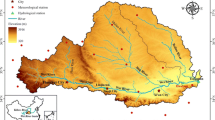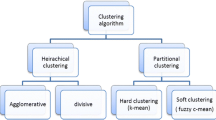Abstract
Climate change and human activities have led to nonstationarity in hydrological series. To systematically consider nonstationarity in regional frequency analysis (RFA), the features accounting for temporal variability of data series were developed and a nonstationary index flood model considering the trend and jump mutations was proposed in this study. The features extracted by empirical mode decomposition (EMD) were regarded as attributes to identify homogeneous regions. The fuzzy c-means clustering (FCM) and the combination of the self-organizing feature map and Ward’s agglomerative hierarchical clustering (SOM+Ward) were compared. Then the complete nonstationary RFA was applied to the annual maximum daily precipitation (AMDP) of Jiangxi province, China. The results indicate that the regionalization with the attributes reflecting temporal variability of the data series is more detailed. Moreover, the performance of SOM+Ward is better than FCM. The comparison results of precipitation quantiles, which were estimated by stationary and the proposed nonstationary index model, indicate that ignoring nonstationarity in RFA affects the choice of the best-fit distribution and the determination of index flood. In addition, the complete framework of nonstationary RFA developed in this study can provide more proper information when stations with trend and jump mutations exist in the region.









Similar content being viewed by others
Data Availability
The authors have restrictions on sharing data publicly.
References
Ballari D, Giraldo R, Campozano L et al (2018) Spatial functional data analysis for regionalizing precipitation seasonality and intensity in a sparsely monitored region: unveiling the spatio-temporal dependencies of precipitation in Ecuador. Int J Climatol 38:3337–3354. https://doi.org/10.1002/joc.5504
Bezdek JC (1974) Numerical taxonomy with fuzzy sets. J Math Biology 1:57–71. https://doi.org/10.1007/BF02339490
Bezdek JC (1981) Pattern recognition with fuzzy objective function algorithms. Plenum Press, New York
Bezdek JC, Ehrlich R, Full W (1984) FCM: the fuzzy c-means clustering algorithm. Comput Geosci 10(2–3):191–203. https://doi.org/10.1016/0098-3004(84)90020-7
Burn DH (1997) Catchment similarity or regional flood frequency analysis using seasonality measures. J Hydrol 202:212–230. https://doi.org/10.1016/S0022-1694(97)00068-1
Burn DH, Zrinji Z, Kowalchuk M (1997) Regionalization of catchments for regional flood frequency analysis. J Hydrol Eng 2(2):76–82. https://doi.org/10.1061/(ASCE)1084-0699(1997)2:2(76)
Campello RJGB, Hruschka ER (2006) A fuzzy extension of the silhouette width criterion for cluster analysis. Fuzzy Sets Syst 157:2858–2875. https://doi.org/10.1016/j.fss.2006.07.006
Cassalho F, Beskow S, De Mello CR et al (2019) Evaluation of flood timing and regularity over hydrological regionalization in southern Brazil. J Hydrol Eng 24(8):05019022. https://doi.org/10.1061/(ASCE)HE.1943-5584.0001815
Cicone A, Liu JF, Zhou HM (2016) Adaptive local iterative filtering for signal decomposition and instantaneous frequency analysis. Appl Comput Harmon Anal 41:384–411. https://doi.org/10.1016/j.acha.2016.03.001
Cunderlik JM, Burn DH (2003) Non-stationary pooled flood frequency analysis. J Hydrol 276:210–223. https://doi.org/10.1016/S0022-1694(03)00062-3
Das S (2020) Assessing the regional concept with sub-sampling approach to identify probability distribution for at-site hydrological frequency analysis. Water Resour Manag 34:803–817. https://doi.org/10.1007/s11269-019-02475-6
Di Prinzio M, Castellarin A, Toth E (2011) Data-driven catchment classification: application to the pub problem. Hydrol Earth Syst Sci 15:1921–1935. https://doi.org/10.5194/hess-15-1921-2011
Dikbas F, Firat M, Koc AC et al (2012) Classification of precipitation series using fuzzy cluster method. Int J Climatol 32:1596–1603. https://doi.org/10.1002/joc.2350
Dunn JC (1973) A fuzzy relative of the ISODATA process and its use in detecting compact, well-separated clusters. J Cybern 3(3):32–57. https://doi.org/10.1080/01969727308546046
Farsadnia F, Kamrood MR, Nia AM et al (2014) Identification of homogenous regions for regionalization of watersheds by two-level self-organizing feature maps. J Hydrol 509:387–397. https://doi.org/10.1016/j.jhydrol.2013.11.050
Goyal MK, Gupta V (2014) Identification of homogeneous rainfall regimes in northeast region of India using fuzzy cluster analysis. Water Resour Manag 28:4491–4511. https://doi.org/10.1007/s11269-014-0699-7
Guntu RK, Maheswaran R, Agarwal A, Singh VP (2020) Accounting for temporal variability for improved precipitation regionalization based on self-organizing map coupled with information theory. J Hydrol 590:125236. https://doi.org/10.1016/j.jhydrol.2020.125236
Hanel M, Buishand TA, Ferro CAT (2009) A nonstationary index flood model for precipitation extremes in transient regional climate model simulations. J Geophys Res Atmos 114:D15107. https://doi.org/10.1029/2009JD011712
Hazarika J, Sarma AK (2021) Importance of regional rainfall data in homogeneous clustering of data-sparse areas: a study in the upper Brahmaputra valley region. Theor Appl Climatol 145:1161–1175. https://doi.org/10.1007/s00704-021-03686-x
Hosking JRM, Wallis JR (1993) Some statistics useful in regional frequency analysis. Water Resour Res 29(2):271–281. https://doi.org/10.1029/92WR01980
Hosking JRM, Wallis JR (1997) Regional frequency analysis: an approach based on L-moments. Cambridge University Press, New York
Hsu KC, Li ST (2010) Clustering spatial–temporal precipitation data using wavelet transform and self-organizing map neural network. Adv Water Resour 33:190–200. https://doi.org/10.1016/j.advwatres.2009.11.005
Hu YM, Liang ZM, Jiang XL et al (2015) Non-stationary hydrological frequency analysis based on the reconstruction of extreme hydrological series. Proc IAHS 371:163–166. https://doi.org/10.5194/piahs-371-163-2015
Huang NE, Shen Z, Long SR et al (1998) The empirical mode decomposition and the Hilbert spectrum for nonlinear and non-stationary time series analysis. Proc R Soc Lond A 454:903–995
Kendall MG (1975) Rank correlation methods. Charles Griffin, London
Kiang MY (2001) Extending the Kohonen self-organizing map networks for clustering analysis. Comput Stat Data Anal 38(2):161–180. https://doi.org/10.1016/S0167-9473(01)00040-8
Kim H, Shin JY, Kim T et al (2020) Regional frequency analysis of extreme precipitation based on a nonstationary population index flood method. Adv Water Resour 146:103757. https://doi.org/10.1016/j.advwatres.2020.103757
Kohonen T (1982) Self-organized formation of topologically correct feature maps. Biol Cybern 43:59–69. https://doi.org/10.1007/BF00337288
Kohonen T (1990) The self-organizing map. Proc IEEE 78(9):1464–1480. https://doi.org/10.1109/5.58325
Kundzewicz ZW, Robson AJ (2004) Change detection in hydrological records—a review of the methodology. Hydrol Sci J 49(1):7–19. https://doi.org/10.1623/hysj.49.1.7.53993
Lee T, Ouarda TBMJ (2010) Long-term prediction of precipitation and hydrologic extremes with nonstationary oscillation processes. J Geophys Res Atmos 115:D13107. https://doi.org/10.1029/2009JD012801
Ley R, Casper MC, Hellebrand H et al (2011) Catchment classification by runoff behaviour with self-organizing maps (SOM). Hydrol Earth Syst Sci 15:2947–2962. https://doi.org/10.5194/hess-15-2947-2011
Liang YY, Liu SG, Guo YP et al (2017) L-moment-based regional frequency analysis of annual extreme precipitation and its uncertainty analysis. Water Resour Manag 31:3899–3919. https://doi.org/10.1007/s11269-017-1715-5
Mann HB (1945) Nonparametric tests against trend. Econometrica 13(3):245–259. https://doi.org/10.2307/1907187
Milly PCD, Betancourt J, Falkenmark M et al (2008) Stationarity is dead: whither water management? Science 319(5863):573–574. https://doi.org/10.1126/science.1151915
Nam W, Kim S, Kim H et al (2015) The evaluation of regional frequency analyses methods for nonstationary data. Proc IAHS 371:95–98. https://doi.org/10.5194/piahs-371-95-2015
O’Brien NL, Burn DH (2014) A nonstationary index-flood technique for estimating extreme quantiles for annual maximum streamflow. J Hydrol 519:2040–2048. https://doi.org/10.1016/j.jhydrol.2014.09.041
Pal NR, Bezdek JC (1995) On cluster validity for the fuzzy c-means model. IEEE Trans Fuzzy Syst 3(3):370–379. https://doi.org/10.1109/91.413225
Pettitt AN (1979) A non-parametric approach to the change-point problem. Appl Stat 28(2):126–135. https://doi.org/10.2307/2346729
Rasheed A, Egodawatta P, Goonetilleke A et al (2019) A novel approach for delineation of homogeneous rainfall regions for water sensitive urban design—a case study in southeast Queensland. Water 11(3):570. https://doi.org/10.3390/w11030570
Satyanarayana P, Srinivas VV (2011) Regionalization of precipitation in data sparse areas using large scale atmospheric variables—a fuzzy clustering approach. J Hydrol 405:462–473. https://doi.org/10.1016/j.jhydrol.2011.05.044
Sen PK (1968) Estimates of the regression coefficient based on Kendall’s tau. J Am Stat Assoc 63:1379–1389. https://doi.org/10.1080/01621459.1968.10480934
Sung JH, Kim YO, Jeon JJ (2018) Application of distribution-free nonstationary regional frequency analysis based on L-moments. Theor Appl Climatol 133:1219–1233. https://doi.org/10.1007/s00704-017-2249-8
Vesanto J, Alhoniemi E (2000) Clustering of the self-organizing map. IEEE Trans Neural Netw 11(3):586–600. https://doi.org/10.1109/72.846731
Ward JH (1963) Hierarchical grouping to optimize an objective function. J Am Stat Assoc 58(301):236–244. https://doi.org/10.1080/01621459.1963.10500845
Wei T, Song SB (2019) Utilization of the copula-based composite likelihood approach to improve design precipitation estimates accuracy. Water Resour Manag 33:5089–5106. https://doi.org/10.1007/s11269-019-02416-3
Wu ZH, Huang NE, Long SR et al (2007) On the trend, detrending, and variability of nonlinear and nonstationary time series. Proc Natl Acad Sci USA 104(38):14889–14894. https://doi.org/10.1073/pnas.0701020104
Xie XL, Beni G (1991) A validity measure for fuzzy clustering. IEEE Trans Pattern Anal Mach Intell 13(8):841–847. https://doi.org/10.1109/34.85677
Acknowledgements
The authors are grateful to the editors and anonymous reviewers for their invaluable comments and suggestions.
Funding
This study was supported by the National Key Research and Development Program of China (Grant Nos. 2018YFC1508200 and 2018YFC1508001), the Fundamental Research Funds for the Central Universities (Grant Nos. B200204029) and the National Natural Science Foundation of China (Grant No. 51479061).
Author information
Authors and Affiliations
Contributions
QG: Methodology, Data Curation, Writing—original draft. GL: Methodology, Editing of the manuscript, Supervision. JB: Data Curation, Validation. JW: Conceptualization, Data Curation.
Corresponding author
Ethics declarations
Ethical Approval
The authors certify that the submission is original work and is not published at any other publications.
Consent to Participate
The authors declare that they consent to participate in this work.
Consent to Publish
The authors declare their consent to publication of this manuscript on “Water Resources Management” journal.
Conflict of Interest
None.
Additional information
Publisher's Note
Springer Nature remains neutral with regard to jurisdictional claims in published maps and institutional affiliations.
Supplementary Information
Below is the link to the electronic supplementary material.
Rights and permissions
About this article
Cite this article
Gao, Q., Li, G., Bao, J. et al. Regional Frequency Analysis Based on Precipitation Regionalization Accounting for Temporal Variability and a Nonstationary Index Flood Model. Water Resour Manage 35, 4435–4456 (2021). https://doi.org/10.1007/s11269-021-02959-4
Received:
Accepted:
Published:
Issue Date:
DOI: https://doi.org/10.1007/s11269-021-02959-4




